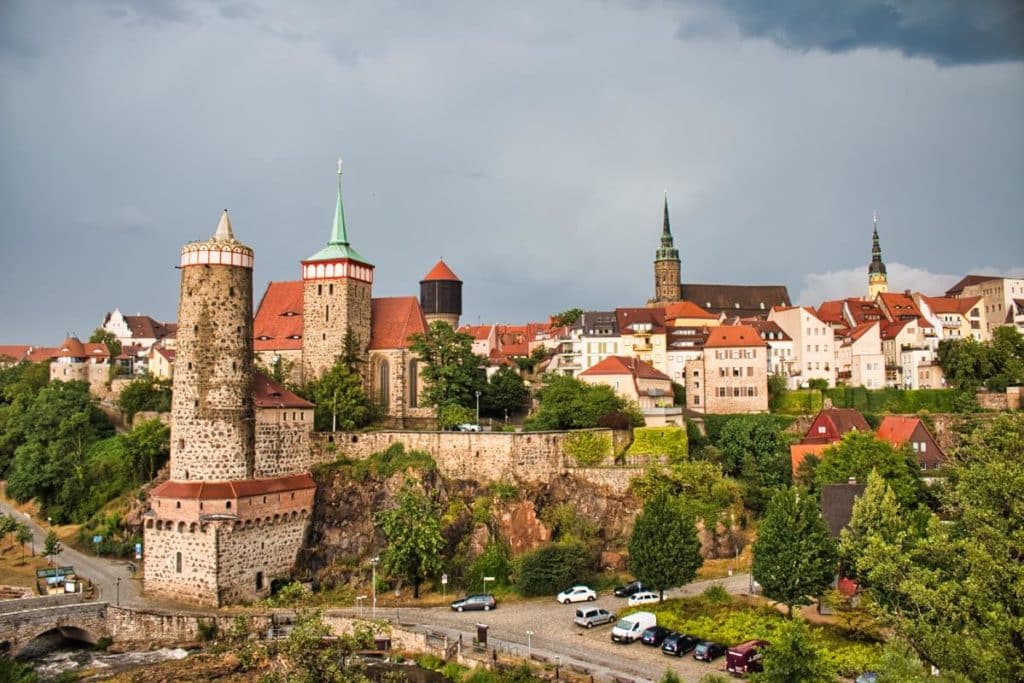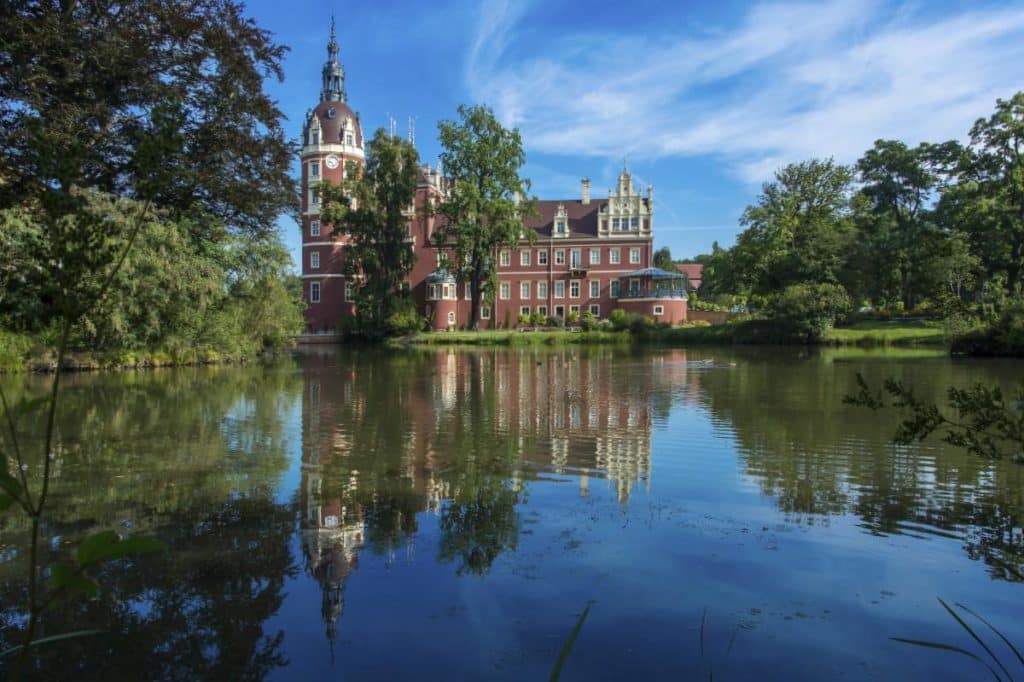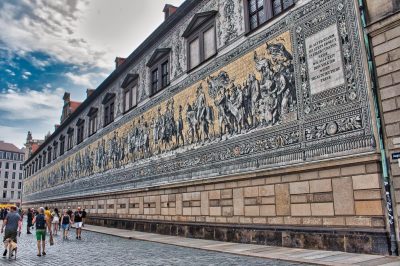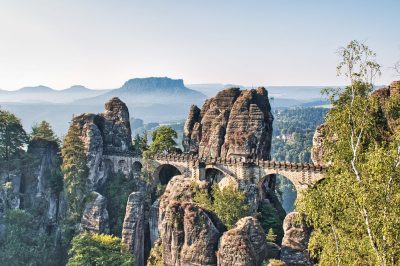What Bavaria is for the whole country, Saxony is for East Germany. It is not uncommon for the Saxon dialect to be referred to as “East German”.
Sachsen Germany sights are also generally considered to be some of the most interesting sights in eastern Germany. And in fact, a visit to Dresden or Leipzig is now also on the itinerary of many foreign visitors.
These are the most beautiful sights in Sachsen Germany
Here we present you the most beautiful sights in Saxony. And if you click here, you will come to our Saxony travel tips.
Dresden with Frauenkirche
The Frauenkirche Dresden is now once again one of the most beautiful sights in eastern Germany. This is amazing, because not much was left of the church by the time of German reunification. Badly damaged by bombs during World War II, the GDR authorities had the remains of the Frauenkirche blown up. It was not until after the fall of the Wall that reconstruction began. Today, the church with its unique marble interior shines again in its former glory. The Zwinger, the Semper Opera House or the Old Masters Gallery as well as the Fürstenzug are also worth a visit. Dresden is simply a beauty and rightly belongs to the most amazing cities in Europe. If you prefer something more alternative, Dresden-Neustadt is the right place.

Saxon Switzerland and Elbe Sandstone Mountains
Saxon Switzerland and the Elbe Sandstone Mountains with their bizarre rock formations provide the perfect setting for some of the best hiking in Germany. A photo of the Bastei Bridge belongs on any good Germany photo calendar. The Königstein Fortress gives the impression that the region was also always a border region and knew how to defend itself. The view of the Elbe valley is particularly beautiful. What more do you want?

Görlitz
Görlitz has probably been the great unknown in Saxony until a few years ago. But that has changed considerably since some well-known Hollywood films were shot in Görlitz. Now, more and more tourists are also discovering the bipartite city on the Neisse River, which also forms the border to Poland here. The old town with its many sights is well renovated. In the Görlitz department store you can feel the spirit of the early 20th century, when department stores were real temples of consumption. Also because of the atmosphere, the foyer served as a backdrop for the movie Grand Budapest Hotel. You should also not miss the Upper Lusatian Library of Sciences, which is one of the most beautiful in the country.

Zittau and the Zittau Mountains
Zittau is quite a small city, but it lies at the foot of the mountain range named after the city. St. John’s Church, designed by Berlin architect Karl Friedrich Schinkel, bears witness to the town’s former importance. The Great Lenten Cloth of Zittau is one of the most beautiful medieval works of art in Germany. And with the Small Lenten Cloth there is even another one of world rank. Trips from Zittau to the spa towns of Jonsdorf or to the Oybin Monastery are especially fun on the Zittau narrow-gauge railroad and cost much less than a comparable trip on other railroads.

Bautzen
Bautzen, on the other hand, situated on a hill and surrounded by a fortress wall, impresses with its medieval old town. From the Reichenberg Gate you have a magnificent view over the roofs of Bautzen. In the Old Waterworks you can learn everything about water production in the Middle Ages. And in the Sorbian Museum you can learn about our Slavic minority in Germany, its history, culture and customs.

Moritzburg Castle
For almost every East German, Moritzburg Castle is already known because it provided the backdrop for the DEFA film “Three Hazelnuts for Cinderella”. This film is something like the unofficial Christmas movie in the East. And with its location in the middle of the artificial Moritzburg ponds, this Baroque gem is definitely a must-see when visiting Saxony, and absolutely Instagram-worthy.

Meissen
Meissen calls itself the cradle of Saxony. And indeed, Meissen is one of the oldest places in Saxony. Slavic tribes, on which the Sorbs go back, already settled in Meissen. Henry I had a castle built here in 929. Today called Albrechtsburg, you have a unique view from the castle hill over the Elbe valley and the surrounding old town. In the porcelain manufactory you will learn everything about the history of the “white gold”, which has been produced here since the founding of the manufactory by August the Strong. Afterwards, you can enjoy one of the fantastic wines, for example from the “Prinz zur Lippe” winery in Proschwitz – that makes Saxony even more appealing!

Kriebstein Castle
Kriebstein Castle is one of the most beautiful castles in the state. It towers above the small river Zschopau, which runs in an arc around the castle on the rock. It nestles against the rock in such a way that it almost forms a unit with it. This made it difficult for attackers to conquer. This could also be a reason why a legend says that the legendary Amber Room was stored here, or perhaps is still hidden here. However, we think that the medieval knight’s castle is worth a visit even without the Amber Room.

Muskau Park
Everyone probably knows the three-colored Pückler ice cream in Germany. The prince who gave the ice its name, however, is probably only known to a few. Yet he had one of the most beautiful landscape parks in Germany built in Bad Muskau. The picturesque paths, dreamy caves, romantic bridges – Muskau Park is one of the most beautiful destinations in eastern Saxony – and in Poland. After all, only a third of the park is in Germany.
Two thirds are east of the Neisse River in Poland. Therefore, this park is certainly one of the most beautiful border experiences and the joint maintenance of the park is one of the best projects of German-Polish cooperation. UNESCO also sees it that way and has included the Muskau Park in its World Heritage List.

Leipzig
Being the largest city in the Free State of Saxony and a proper student city, Leipzig has experienced a major upswing in the last three decades. Many new buildings such as the main university building, the Porsche and BMW factories, the City Tunnel and others testify to Leipzig’s development back to its former greatness. From the City-Hochhaus you have a good overview of the city. At the “Karli” you can store well and in Plagwitz wonderful canoeing and end the evening with a beer in one of the countless pubs.

Torgau
Torgau is often neglected in the list of Luther sites, but it was very important for the success of the Reformation. Hartenfels Castle was not only a castle of the Prince Elector who supported Luther. The town’s citizens also shared his ideas. Katharina von Bora, who married Luther in 1525, once fled from a monastery in the town. Later she died here, fleeing from the plague from Wittenberg.

Ore Mountains
The Ore Mountains are not only one of the most beautiful natural regions with countless forests and the highest peak of the former GDR, the Fichtelberg. The former mining region was only added to the UNESCO World Heritage List in 2019. And indeed, the mining heritage is one of the most exciting stories in Saxony. Many of the mines can be visited, and old winding towers and waste rock piles still characterize the landscape today. For many, however, the Ore Mountains or Erzgebirge as tehy are called in German, only become truly homey during Advent, when everything revolves around Christmas with its nutcrackers, candle arches, incense candles and Christmas pyramids, that are produced here.

Chemnitz
Few visitors to Saxony will have Chemnitz, renamed Karl-Marx-Stadt in GDR times, on their radar. Yet there is an astonishing amount to see here. Chemnitz rightly advertises itself as a “city of modernity”. Here you can find some of the most interesting buildings of the interwar period, in which the ideas of the New Building can be found. Chemnitz has many buildings to offer that can be seen as blueprints for the further development of modern architecture.
The iconic Karl Marx Monument in the center also shows the traces left by the GDR in the city named after the philosopher. At the Museum of Industrial Culture, you’ll learn more about the industrial history of the “Saxon Manchester” and the railroad king Richard Hartmann, who later built the famous locomotive factory in what is now Ukraine.

Vogtland
Saxony’s Vogtland region is also often overlooked. Despite the fact that it is located on the A9, many people just drive by. Yet the region is very worthwhile for visitors. In the old town of Plauen it is nice to walk around and here you can learn more about the production of the traditional Plauen lace. The Göltzschtal Bridge is one of the most beautiful railroad bridges in Germany and looks like a Roman viaduct with its brick architecture. Some of the world’s finest instruments are made in Marktneukirchen. You can visit the instrument makers in their workshops here. And for more than a few ski jumping fans, the Vogtland Arena with its elevator is an absolute highlight. For everyone else, there is a fantastic view of the Vogtland from here.
Book recommendations
Do you feel like a trip to Saxony? Then we recommend the following books!
No products found.
Good, short overview of Saxony and it’s history.
No products found.
Beautifully illustrated book with lots of pictures of Saxony.
No products found.



